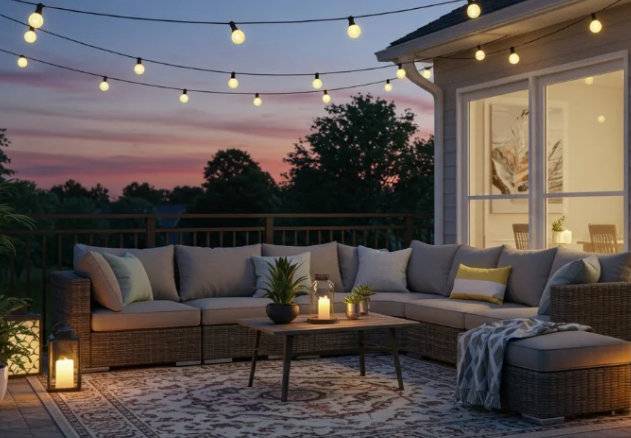Introduction
The term markiseteppe is somewhat unusual and is not widely used in standard dictionaries, but by deconstructing it, we can gain insight into its possible meaning and applications.
- Markise is a German / Scandinavian term meaning awning or canopy (a structure or fabric used to shade windows, terraces, or outdoors).
- Teppe is a Scandinavian word meaning carpet, mat, or rug.
- Thus, markiseteppe roughly suggests “awning carpet” or “canopy mat” — that is, a fabric covering that serves as both a protective shade and a “ground” or “floor” covering in outdoor settings.
In practical usage, “markiseteppe” can refer to:
- An awning-compatible rug or carpet that is placed under or near an awning (markise) for outdoor comfort and aesthetics (e.g. on terraces, patios, under tents).
- A fabric covering or sheet that acts as a floor mat under a canopy or tent, especially in camping, caravan, or outdoor lounge setups.
- A hybrid concept or product combining canopy/awning fabric with rug-like properties — durable, weather-resistant, decorative, and functional.
- As a brand name or niche term in outdoor furnishing, it may be used to market specific products (shade cloths, carpets, outdoor mats) under the unique label “Markiseteppe.”
- In some markets (Nordic, Scandinavian, camping gear), similar terms exist for tepper til markise (“rugs for awnings”) in camping or caravan accessory catalogs.
Because it is a niche or composite term, using “markiseteppe” in SEO or marketing can help you target a less saturated keyword space, especially within Scandinavian or outdoor living / camping niches.
Why Markiseteppe Is Useful: Benefits & Use Cases
Here are key advantages and application areas where a well-chosen markiseteppe (awning rug / mat) shines.
1. Comfortable Underfoot in Outdoor Spaces
One of the main benefits of placing a rug or carpet under your awning or canopy is to make the floor area more comfortable. Instead of bare concrete, stone, or gravel, a markiseteppe gives:
- A soft surface to walk on
- A cozy, homey ambiance
- Insulation from ground cold or dampness
- A delineated “outdoor room” floor area
2. Protection & Cleanliness
A markiseteppe helps catch dirt, sand, leaves, and debris so that your seating or lounging area stays cleaner. It also protects patio flooring, deck boards, or tent floors from scratching or wear.
3. Shading / Climate Regulation (Indirect)
While the markiseteppe itself does not provide shade, combined with a markise (awning) above, it supports a more comfortable microclimate: the awning provides shade and blocks direct sunlight and rain, while the markiseteppe ensures the ground area stays usable and pleasant.
Some marketing sources claim that combining awnings and outdoor coverings can reduce indoor cooling needs (by shading windows) by up to 30 %.
4. Aesthetic & Design Cohesion
A well-designed markiseteppe can be a decorative element. You can choose patterns, colors, textures that harmonize with your home’s style, outdoor furniture, and surrounding landscape. It unifies the visual look of your patio or terrace.
5. Versatility for Camping, Caravans & Events
In camping and caravan contexts, markiseteppe (or tepper til markise) are commonly used under awnings and tents to provide a “floor mat” space. Nordisk Camping Utstyr offers such products, emphasizing durability, easy-clean materials, and fast delivery.
Other camping / caravan webshops list “teppetilbehør” (mat accessories) for awnings, including ropes, clips, etc.
Thus, markiseteppe is especially relevant in outdoor leisure, seasonal homes, campsites, and events.
Choosing a Good Markiseteppe: Materials, Size & Features
To get good value and long life from a markiseteppe, you should pay attention to several parameters.
Material & Weather Resistance
Because the markiseteppe is used outdoors, the fabric and backing materials must resist UV, moisture, mildew, dirt, and abrasion.
Common materials / fabric types:
- Polypropylene (PP) / polyolefin: Common in outdoor rugs; lightweight, quick-drying, mildew-resistant.
- Polyester blends: Offers a balance between cost and durability.
- PVC-coated fabrics: Heavier but more waterproof.
- Acrylic: UV-resistant, colorfast fabrics often used for awning canopies.
- Woven synthetic blends: Good combination of strength and flexibility.
When selecting, consider:
- UV protection / colorfastness
- Water drainage / breathability
- Easy to clean (hoseable, wipeable)
- Anti-slip backing or texture
- Reinforced edges / hemmed borders
- Weight (heavier rugs resist wind)
- Folds / storage considerations
Size, Shape & Layout
Your markiseteppe should be sized appropriately:
- It should ideally cover the ground area beneath the awning, with some margin.
- If your awning is retractable, the markiseteppe area should not get in the way of retraction.
- Modular or multi-panel rugs may help for irregular spaces.
- Shapes: rectangular, square, roll, or custom-cut.
Edges, Fastening & Stability
To avoid flapping or displacement in wind, good markisetepper often include:
- Grommets / eyelets for stakes or ropes
- Velcro or hook attachments
- Weighted edges
- Anti-slip backing
- Reinforced corners
Aesthetic Options & Patterns
Because this is also a decorative feature, you should choose patterns that blend with your home or outdoor décor:
- Stripes, geometric motifs, solids
- Natural / muted tones or bold accent colors
- Seamless joins or modular tiling
- Contrasting borders
Durability & Warranty
Look for warranties or performance specs (e.g. “UV fade resistance 5,000 hours”) when available. High-end products will advertise lifetime or multi-year guarantees.
Installation Tips & Best Practices
To maximize the utility and lifespan of your markiseteppe, follow these best practices.
1. Prepare the Base Surface
Ensure the underlying surface is relatively clean, level, and free from sharp objects. Stones, twigs, or uneven edges can cause abrasion.
2. Secure Edges & Corners
Use stakes, ropes, grommets, or weights to fasten the markiseteppe securely to the ground, especially in windy conditions.
3. Match with the Awning (Markise)
Coordinate the markiseteppe layout with the awning so that shaded areas and rug areas align. Avoid areas where rain drips off the awning onto bare rug edges that could collect water.
4. Allow for Drainage
Avoid creating water traps. If water accumulates under the rug, mold and mildew may develop. Some rugs are perforated or breathable to allow drainage.
5. Seasonal Storage
If you live in climates with harsh winters or storms:
- Roll or fold the markiseteppe and store it in a dry place
- Clean and dry before storage
- Avoid permanent exposure to intense sun when not in use
6. Periodic Cleaning & Maintenance
Regular sweeping, hosing off with mild soap, and spot treatment help maintain the look and hygiene. Use gentle brushes; avoid harsh chemicals or bleach unless the product specifically allows it.
Market & Pricing Overview
Because markiseteppe is a niche product, pricing varies widely depending on region, quality, and brand.
- In Scandinavian markets (Norway, Sweden, Denmark), “markiseduker” or tepper til markise are commonly offered. For example, Nordisk Camping Utstyr lists markisetepper with delivery in 1–2 business days.
- Camping accessory shops in Norway list teppetilbehør for awnings (grommets, fasteners, standard mats) at modest cost.
- In Finland / the Nordic region, “telttepper” (tent carpets) are sold in tent & awning accessory categories.
- The cost depends heavily on size (square meters), material (premium UV-resistant, coated, thick weave), custom shaping, and brand markup.
As a rough range (depending on region and quality), small to medium markisetepper might cost anywhere from moderate to premium pricing — but comparing among vendors in your local or regional market is advisable.
Because the term “markiseteppe” is relatively unique, using it in your product names or marketing can help you capture niche search traffic with less competition.
Challenges & Considerations
While markiseteppe is a useful and visually appealing concept, there are some challenges to be aware of:
- Wind & Stability: Lightweight rugs in windy environments may flap or shift, so securing them properly is critical.
- Moisture / Mold: If water gets trapped beneath, mold or mildew may develop in humid climates. Proper drainage and cleaning are essential.
- Sun Fade: Even outdoor fabrics can fade over time; UV protection is necessary.
- Wear & Tear: High foot traffic or abrasive surfaces underneath may shorten lifespan.
- Cost vs. Utility: For some users, a simpler ground covering (e.g. plain outdoor mat) may suffice. The premium version must justify the cost via durability or aesthetics.
Summary & Outlook
“Markiseteppe” is a niche but promising concept that combines the function of awning-related fabric / coverings with the comfort and design of a rug or mat. It is especially relevant in outdoor living, camping / caravan setups, terraces, patios, cafés, and event spaces.
By choosing durable materials, thoughtful design, and careful installation/maintenance, a markiseteppe offers:
- A more comfortable underfoot experience
- Protection and higher cleanliness
- Aesthetic enhancement
- Versatility for climate, events, and lifestyle use
- A distinctive keyword advantage for SEO in a less saturated niche
If you plan to market or publish content around markiseteppe, make sure you pair it with supporting content on awnings, outdoor textiles, maintenance, and local variants.
FAQs About Markiseteppe
What is the difference between a markiseteppe and a regular outdoor rug?
A markiseteppe is specifically designed to be used under or in conjunction with an awning (markise). It tends to include features like grommets, weighted edges, drainage, and compatibility with awning layouts. A regular outdoor rug is more generic and may lack these specialized features.
Can I leave a markiseteppe out in rain or snow all year long?
While many markisetepper are designed to resist moisture, UV, and mildew, it’s best to roll up or remove them in extreme weather (snow, heavy storms) to preserve longevity. Ensure the surface dries out, and store it in a dry place when not used.
What materials are best for a markiseteppe in wet climates?
Synthetic fibers like polypropylene, polyester blends, or PVC-coated fabrics are ideal. They dry quickly, resist mold and mildew, and tolerate cyclical wet/dry conditions better than natural fibers.
How do I fix a markiseteppe so it doesn’t shift in wind?
Use grommets and stake it down, attach ropes to anchor points, use weighted edges or sandbags, or choose rugs with anti-slip backing. In permanent installations, you may bolt or tie down corners carefully to the ground or patio frame.
How should I maintain and clean a markiseteppe?
- Shake or sweep off loose debris regularly
- Use a garden hose or gentle pressure washer (low pressure)
- Use mild soap and a soft brush for stains
- Rinse thoroughly and air-dry completely before rolling/folding
- Store in a dry, ventilated place when not in use
- Avoid harsh chemicals, bleach, or abrasive scrubbing





